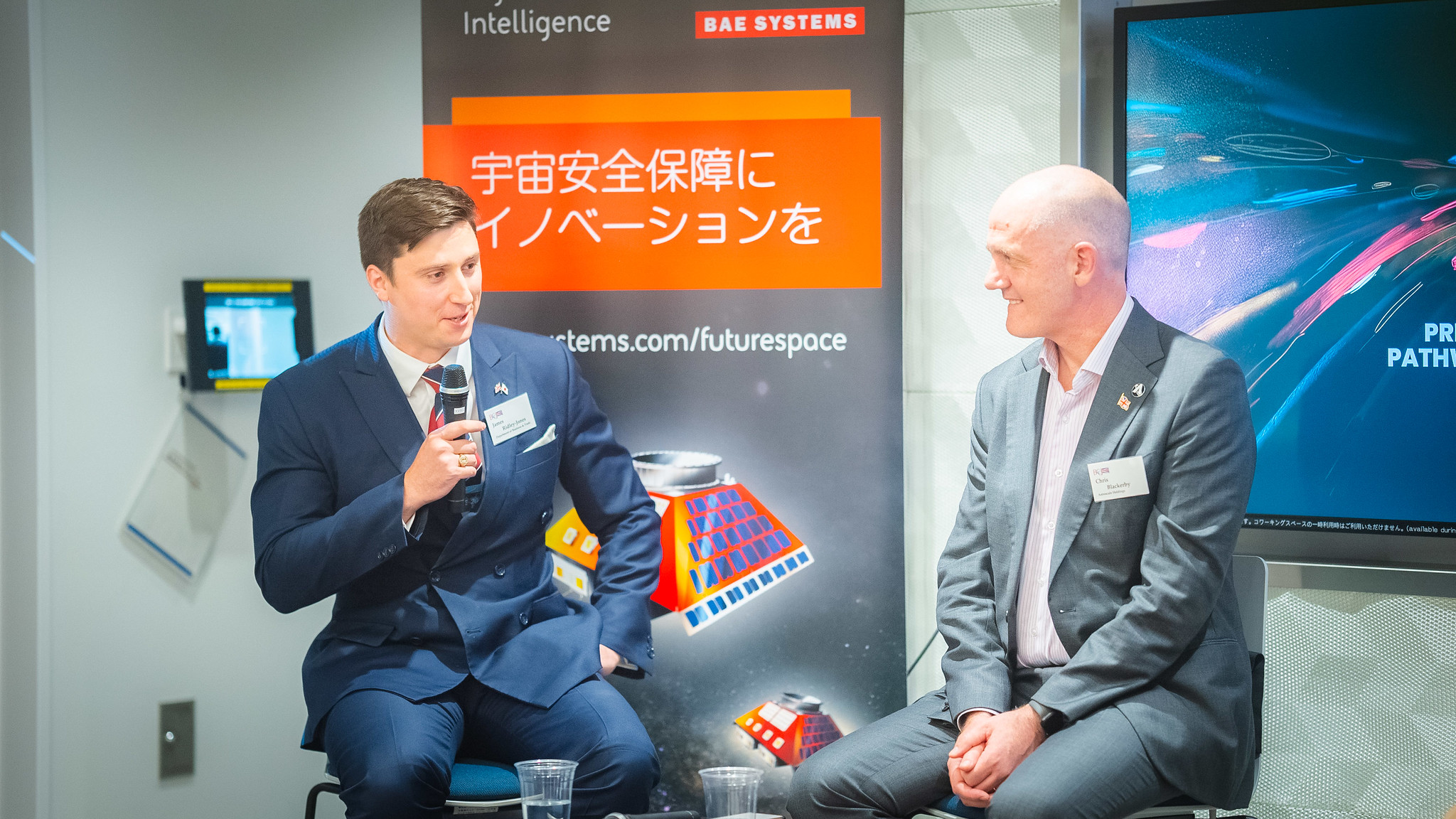Member? Please login
Charting the Future of Space Ventures in the UK and Japan

Written by Sterling Content
July 26, 2024
Past Event Round Ups
The global space economy could be worth US$1.8 trillion by 2035, up from US$630 billion in 2023, according to the World Economic Forum. With this growth potential, the UK and Japan are emerging as key players in the rapidly evolving sector, leveraging their unique strengths to drive bilateral innovation and collaboration like never before.
Among the topics under consideration by UK and Japan partners are national priorities and strengths, space sustainability and engagement beyond space. These issues and more were discussed at a British Chamber of Commerce in Japan event, held in Tokyo in early July.
Hosted by X-Nihonbashi and supported by BAE Systems, the event was moderated by Peter Harris, partner at Clifford Chance, and featured speakers Chris Blackerby, group chief operating officer at Astroscale Holdings; Jenna Rhodes-Tiwana, senior strategy & BD advisor at ispace inc; and James Ridley-Jones of the space sector team at the Department for Business and Trade (DBT).
UK and Japan partnerships
Susan Oliver, the British Embassy Tokyo’s Counsellor for defence, cyber, security, space and aerospace, said the Hiroshima Accord’s strengthening of the UK–Japan partnership would “further reinforce collaboration in outer space, including building global support for norms of responsible space behaviour to maintain a safe, secure and resilient space environment, to reduce space threats and encourage cooperation between our industries.”
She highlighted the UK Space Agency’s International Bilateral Fund, which is focused on supporting the UK space sector to work directly with international partners including Japan. Examples include the University of Leicester’s work with partners in the UK, United States and Japan on radio isotopes; the University of Bradford and Satellite Applications Catapult partnership with the Japan Aerospace Exploration Agency (JAXA) and Fujitsu (Japan) on artificial intelligence space analytics and operational efficiencies for satellite constellations.
“We are a world leader in science and innovation, and the UK space sector is currently worth over £17 billion and employs almost 50,000 people,” Oliver said. “We have invested over £50 million in recent years to develop UK launch capabilities and over £80 million in space weather forecasting projects, to protect critical national infrastructure.
“The sector has shown strong growth over the past 20 years, with an average long-term growth rate of 6%, which is significantly outpacing the growth of the wider UK economy and the global space economy.”
The DBT’s Ridley-Jones said priorities in space include supporting “space domain awareness; satellite communications; position, navigation and timing; Earth observation and Earth applications; and in-orbit servicing and manufacturing.”
Significantly, some £350 billion worth of the UK economy is underpinned by space-related services, he said.
Public and private support
Ispace’s Rhodes-Tiwana said Japan was leading the way with its space strategy fund, comprising ¥1 trillion over 10 years to support research and the commercialisation of space technology.
She noted Japan’s contribution to NASA’s Artemis campaign, which involves exploring the Moon in preparation for human missions to Mars. JAXA and Toyota will contribute a lunar cruiser vehicle, while a Japanese astronaut will become the first non-American astronaut on the Moon.
Astroscale’s Blackerby said development of space “is not going to be confined to just government work; it’s going to be focused on business.”
He said the UK was the only country to support Tokyo-based Astroscale’s first mission in 2016, which he described as “an incredible story about bilateral cooperation between the UK and Japan.”
Discussing the growth of the commercial space industry, Rhodes-Tiwana said ispace’s second mission, planned for 2024, has entirely commercial customers for its payload, helping to boost commercial revenues.
“Access to space is better than it’s ever been … and governments are changing how they see the industry, ranging from specific procurement frameworks like NASA’s to legislating well and putting the stamp of approval on commercial services,” she said.
Ridley-Jones said 80% of space industry revenue in the UK is now commercial, with private investment key to the growth of the sector, which reached US$12.4 billion globally in 2023.

Nevertheless, the growth in private investment has increased pressure on private companies to deliver returns for investors.
“We have done a lot—ispace and Astroscale—and we’ve taken incredible steps proving our technical capabilities, but investors want to see a return,” Blackerby said.
Preserving the environment
Discussing sustainability, Blackerby noted the growth in satellites, from around 2,000 in 2012 to more than 10,000 currently. As a result, “the amount of debris has increased; the number of near misses has increased; the possibility of a collision is not a potential in the future but something that could happen at any time,” he said.
“Just like environmental issues on Earth, we need to be cognisant and take steps to mitigate those risks to the space environment.”
On regulation, Clifford Chance’s Harris noted the “incredibly aspirational” nature of international treaties that aim to provide space regulation, for example the United Nations’ Moon Treaty. However, he emphasised that the sector lacks any international legislation that would provide parties with a means of dispute resolution or enforcement.
“There needs to be some sort of norms and standards that are developed together,” said Rhodes-Tiwana, noting that only four countries have regulations on using space resources.
Asked about the future of space exploration, she suggested the discovery of oxygen resources on the Moon could be used to provide life support for astronauts or to power rockets, potentially supporting future missions to Mars.
Blackerby said space offers the potential for a circular economy, which could aid further exploration: “Our vision is a wholly circular economy in orbit … We want to go up to an object in orbit, repair it, refuel it, if it’s dead, maybe bring it to a commercial space station, maybe there’s a 3D printer, use it to print out a wrench or another satellite, thereby avoiding the launch cost.
“We all have our dreams that are driving us forward, whether it’s a colony on the Moon or a fully circular economy in orbit, but that’s the starting point from where we are now and I think we can get there,” he concluded.







